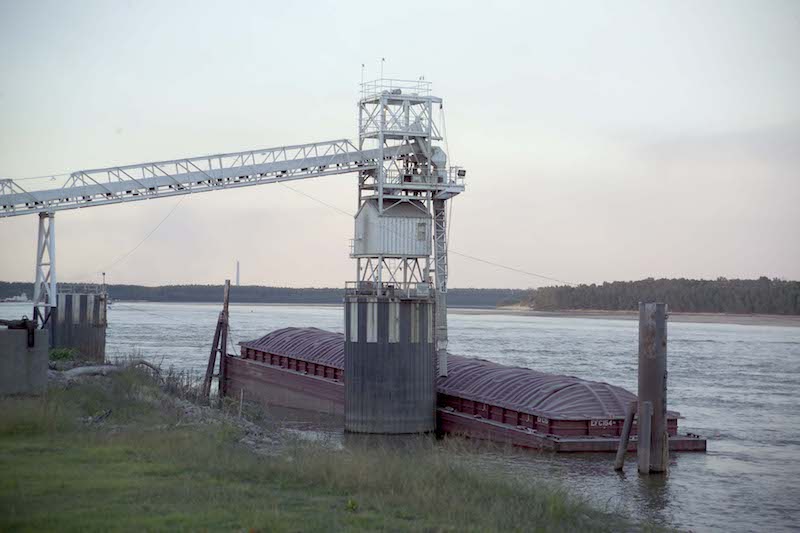In an unusual partnership, U.S. soybean farmers are ponying up $2 million to help finance a joint state-federal initiative to deepen the Lower Mississippi River from Baton Rouge, La., to the Gulf of Mexico.
Considered a key corridor for soybean and corn exports, the area has been hit hard by spring floods and now faces a possible hurricane brewing in the Gulf.
Dredging the lower river from 45 feet to 50 feet in depth would permit access of larger ships and allow current vessels to be loaded with greater quantities of grains, according to the Soy Transportation Coalition. The group cites a report it commissioned that said a deeper channel would increase competitiveness and revenues for U.S. soybeans in the export market.
The report estimated that shipping costs for soybeans from Mississippi Gulf export terminals would drop 13 cents per bushel ($5 per metric ton) if the river channel is dredged to 50 feet. This part of the river is typically dredged to at least 47 feet to prevent vessels from hitting bottom.
The 256-mile stretch of the Mississippi from Baton Rouge to the Gulf accounts for 60% of U.S. soybean exports and 59% of corn exports, as well as petroleum, chemicals and other freight, the coalition said in a statement.
High water from recurrent rains and flooding this spring caused extensive operational problems for shippers, and on Tuesday ship traffic entering and exiting the Lower Miss was suspended due to the expected arrival of Tropical Storm Barry, which could become a Category 1 hurricane by landfall.
Soybean and grain exporters along the river are declaring “force majeure,” a provision in a contract that allows an exporter from fulfilling the contract obligation due to events like weather that are out of their control, according to Mike Steenhoek, executive director of the Soy Transportation Coalition in Ankeny, Iowa.
Faced with numerous challenges to grow and market their crops ranging from loss of the Chinese market due to the ongoing trade dispute between the U.S. and China and the unprecedented flooding, Steenhoek said soybean farmers are willing to invest in improving their transportation network to stay competitive.
The $2 million contribution comes from the United Soybean Board’s checkoff funds that are used to enhance the value and preference of U.S. soy. The funds will be used to plan, design and research the lower Miss channel dredging.
“This is the first time we’ve invested funds in this way for the inland waterway system,” Steenhoek told WorkBoat. “To contribute to an actual project is innovative for us and we’re very excited about it.”
The overall $245 million project involves dredging in three phases, two of which would be cost-shared between the federal government (75%) and non-federal sources (25%). The state of Louisiana would be the non-federal entity.
The first phase involves dredging from Venice, La., to the Gulf (approximately Mile 10 Above Head of Passes (AHP) to the Gulf). The second phase would dredge from Mile 154 at AHP to Baton Rouge and would include the soybean and grain export terminals. The last third phase involves relocation of pipelines buried under the northern portion of the shipping channel. This estimated $80 million project would be split evenly between Louisiana and the pipeline owners.
Research from the soybean coalition estimates that farmers in 31 states will receive an additional $461 million a year for their products once the Lower Miss is dredged to 50 feet. States located the closest to the inland waterway system will realize the most benefits, while those further inland will benefit from higher competition between rail and barge.
“When modal competition increases, a downward pressure on shipping rates will often occur,” the coalition said. “With barge transportation becoming more viable for a larger percentage of the soybean-producing areas of the country, there will be a greater degree of overlap between areas served by railroads and barge. Soybean shippers will benefit from this modal competition.”
Dredging the Lower Miss is a top priority for soybean farmers. “If I had to select a single infrastructure enhancement that would provide the most benefit to the greatest number of soybean farmers, deepening the lower Mississippi River would be my choice,” said Steenhoek. “Soybean farmers are demonstrating a willingness to collaborate with federal and state government on an innovative public private partnership that will enhance the competitiveness of both agriculture and a host of other industries.”
Meanwhile, navigation continued to improve along the Mississippi after major days and shutdowns this spring due to high water and flooding. The Agriculture Department said that as of July 11, the Mississippi River gauge at St. Louis was at 33.7 feet, a decline from higher levels in previous weeks, and that river traffic was slowly returning to normal. This recovery could be disrupted, however, depending on the outcome of Tropical Storm Barry.




